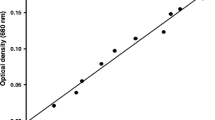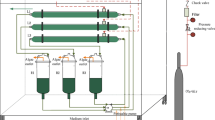Abstract
The aim of this research was to test whether NH4 + and NO3 − affect the growth, P demand, cell composition and N2 fixation of Cylindrospermopsis raciborskii under P limitation. Experiments were carried out in P-limited (200 μg l−1 PO4-P) chemostat cultures of C. raciborskii using an inflowing medium containing either 4,000 μg l−1 NH4-N, 4,000 μg l−1 NO3-N or no combined N. The results showed the cellular N:P and C:P ratios of C. raciborskii decreased towards the Redfield ratio with increasing dilution rate (D) due to the alleviation of P limitation. The cellular C:N and carotenoids:chlorophyll-a ratios also decreased with D, predominantly as a result of an increase in the chlorophyll-a and N content. The NH4 + and NO3 − supply reduced the P maintenance cell quota of C. raciborskii. Consequently, the biomass yield of the N2-grown culture was significantly lower. The maximum specific growth rate of N2-grown culture was also the lowest observed. It is suggested that these differences in growth parameters were caused by the P and energy requirement for heterocyte formation, nitrogenase synthesis and N2 fixation. N2 fixation was partially inhibited by NO3 − and completely inhibited by NH4 +. It was probably repressed through the high N content of cells at high dissolved N concentrations. These results indicate that C. raciborskii is able to grow faster and maintain a higher biomass under P limitation where a sufficient supply of NH4 + or NO3 − is maintained. Information gained about the species-specific nutrient and pigment stoichiometry of C. raciborskii could help to access the degree of nutrient limitation in water bodies.










Similar content being viewed by others
References
Ågren, G. I., 2004. The C:N:P stoichiometry of autotrophs—theory and observations. Ecology Letters 7(3): 185–191.
Ahn, C.-Y., A.-S. Chung & H.-M. Oh, 2002. Rainfall, phycocyanin, and N:P ratios related to cyanobacterial blooms in a Korean large reservoir. Hydrobiologia 474(1–3): 117–124.
Blomqvist, P., A. Pettersson & P. Hyenstrand, 1994. Ammonium-nitrogen, a key regulatory factor causing dominance of non-nitrogen-fixing cyanobacteria in aquatic systems. Archiv für Hydrobiologie 13: 141–164.
Briand, J. F., Ch. Leboulanger, J.-F. Humbert, C. Bernard & P. Dufour, 2004. Cylindrospermopsis raciborskii (Cyanobacteria) invasion at mid-latitudes: selection, wide physiological tolerance, or global warming? Journal of Phycology 40: 231–238.
Bryant, D. A., 1994. The Molecular Biology of Cyanobacteria. Kluwer Academic Publishers, Dordrecht, The Netherlands.
Bulgakov, N. G. & A. P. Levich, 1999. The nitrogen:phosphorus ratio as a factor regulating phytoplankton community structure. Archiv für Hydrobiologie 146: 3–22.
Burford, M. A., K. L. McNeale & F. J. McKenzie-Smith, 2006. The role of nitrogen in promoting the toxic cyanophyte Cylindrospermopsis raciborskii in a subtropical water reservoir. Freshwater Biology 51(11): 2143–2153.
De Nobel, W. T. P., J. L. Snoep, H. V. Westerhoff & L. R. Mur, 1997a. Interaction of nitrogen fixation and phosphorus limitation in Aphanizomenon flos-aquae (Cyanophyceae). Journal of Phycology 33: 794–799.
De Nobel, W. T. P., J. Huisman, J. L. Snoep & L. R. Mur, 1997b. Competition for phosphorus between the nitrogen-fixing cyanobacteria Anabaena and Aphanizomenon. FEMS Microbiology Ecology 24: 259–267.
De Nobel, W. T. P., H. C. P. Matthijs, E. Von Elert & L. R. Mur, 1998. Comparison of the light-limited growth of the nitrogen-fixing cyanobacteria Anabaena and Aphanizomenon. New Phytologist 138: 579–587.
Dokulil, T. M. & K. Teubner, 2000. Cyanobacterial dominance in lakes. Hydrobiologia 438: 1–12.
Droop, M. R., 1973. Some thought on nutrient limitation in algae. Journal of Phycology 17: 257–265.
Geider, R. J. & J. La Roche, 2002. Redfield revisited: variability of C:N:P in marine microalgae and its biochemical basis. European Journal of Phycology 37: 1–17.
Hawkins, P. R., J. Holliday, A. Kathuria & L. Bowling, 2005. Change in cyanobacterial biovolume due to preservation by Lugol’s iodine. Harmful Algae 4(6): 1033–1043.
Healey, F. P., 1978. Physiological indicators of nutrient deficiency in algae. Mitteilungen der Internatinalen Vereinigung für Limnologie 21: 34–41.
Heath, M. R., K. Richardson & T. Kiǿrboe, 1990. Optical assessment of phytoplankton nutrient depletion. Archiv für Hydrobiologie 146: 3–22.
Herodek, S., V. Istvánovics, G. Jolánkai, P. Csathó, T. Németh & Gy. Várallyay, 1995. The P cycle in the Balaton catchment—a Hungarian case study. In Thiessen, H. (ed.), Phosphorus in the Global Environment, Scope 54. Willey: 275–300.
Hyenstrand, P., P. Blomqvist & A. Pettersson, 1998. Factors determining cyanobacterial success in aquatic ecosystems—a literature review. Archiv für Hydrobiologie Special Issues in Advanced Limnology 51: 41–62.
Istvánovics, V., H. M. Shafik, M. Présing & Sz. Juhos, 2000. Growth and phosphate uptake kinetics of the cyanobacterium, Cylindrospermopsis raciborskii (Cyanophyceae) in through flow cultures. Freshwater Biology 43(2): 257–275.
Iwamura, T., H. Nagai & S. Ishimura, 1970. Improved methods for determining contents of chlorophyll, protein, ribonucleic and desoxyribonucleic acid in planktonic populations. Internationale Revue der Gesamten Hydrobiologie 55: 131–147.
Kim, H.-S., S.-J. Hwang, J.-K. Shin, K.-G. An & C. G. Yoon, 2007. Effects of limiting nutrients and N:P ratios on the phytoplankton growth in a shallow hypertrophic reservoir. Hydrobiologia 581: 255–267.
Kapustka, L. A. & J. R. Rosowski, 1976. The response of a Cylindrospermum species to different sources of nitrogen. Proceedings of the Oklahoma Academy of Science 56: 49–52.
Klausmeier, C. A., E. Litchman, T. Daufresne & S. A. Levin, 2004. Optimal N:P stoichiometry of phytoplankton. Nature 429: 171–174.
Kovács, W. A., 2004. Comparative study of the most important planktonic N2-fixing cyanobacteria (Cylindrospermopsis raciborskii, Aphanizomenon flos-aquae) of Lake Balaton. PhD Thesis, Tihany, Hungary (in Hungarian with English abstract).
Kulasooriya, S. A., N. J. Lang & P. Fay, 1972. The heterocysts of blue-green algae. III. Differentiation and nitrogenase activity. Proceedings of the Royal Society of London, Series B, Biological Sciences 181(1063): 199–209.
Layzell, D. B., D. H. Turpin & I. R. Elrifi, 1985. Effect of N source on the steady-state growth and N assimilation of P-limited Anabaena flos-aquae. Plant Physiology 78: 739–745.
Lee, D.-Y. & G.-Y. Rhee, 1997. Kinetics of cell in the cyanobacterium Anabaena flos-aquae and the production of dissolved organic carbon. Journal of Phycology 33: 991–998.
Liu, H., R. R. Bidigara, E. Laws, M. R. Landry & L. Campbell, 1999. Cell cycle and physiological characteristics of Synechococcus (WH7803) in chemostat culture. Marine Ecology Progress Series 189: 17–25.
Meeks, J. C. & J. Elhai, 2002. Regulation of cellular differentiation in filamentous cyanobacteria in free-living and plant-associated symbiotic growth states. Microbiology and Molecular Biology Reviews 66: 94–121.
Meeks, J. C., K. L. Wycoff, J. S. Chapman & C. S. Enderlin, 1983. Regulation of expression of nitrate and dinitrogen assimilation by Anabaena species. Applied and Environmental Microbiology 45(4): 1351–1359.
Mulholland, M. R. & P. W. Bernhardt, 2005. The effect of growth rate, phosphorus concentration, and temperature on N2 fixation, carbon fixation, and nitrogen release in continuous cultures of Trichodesmium IMS 101. Limnology and Oceanography 50(3): 839–849.
Nõges, T., A. Järvet, A. Kisand, R. Laugaste, E. Loigu, B. Skakalski & P. Nõges, 2007. Reaction of large and shallow lakes Peipsi and Võrtsjärv to the changes of nutrient loading. Hydrobiologia 584: 253–264.
Oh, H.-M., J. Maeng & G.-Y. Rhee, 1991. Nitrogen and carbon fixation by Anabaena sp. isolated from a rice paddy and grown under P and light limitations. Journal of Applied Phycology 3: 335–343.
Padisák, J., 1997. Cylindrospermopsis raciborskii (Woloszynska) Seenayya et Subba Raju, an expanding, highly adaptive cyanobacterium: worldwide distribution and review of its ecology. Archiv für Hydrobiologie 107: 563–593.
Padisák, J. & R. C. Reynolds, 1998. Selection of phytoplankton associations in Lake Balaton, Hungary, in response to eutrophication and restoration measures, with special reference to the cyanoprokaryotes. Hydrobiologia 384: 41–53.
Pomogyi, P., 1993. Nutrient retention of the Kis-Balaton Water Protective System. Hydrobiologia 251: 309–320.
Présing, M., S. Herodek, L. Vörös & I. Kóbor, 1996. Nitrogen fixation, ammonium and nitrate uptake during a bloom of Cylindrospermopsis raciborskii in Lake Balaton. Archiv für Hydrobiologie 136: 553–562.
Présing, M., S. Herodek, T. Preston & L. Vörös, 2001. Nitrogen uptake and the importance of internal nitrogen loading in Lake Balaton. Freshwater Biology 46: 125–139.
Reynolds, C. S., 1997. Vegetation Processes in the Pelagic: A Model for Ecosystem Theory. Excellence in Ecology 9. Ecology Institute, Oldendorf/Luhe.
Rhee, G.-Y. & T. C. Lederman, 1983. Effects of nitrogen sources on P-limited growth of Anabaena flos-aquae. Journal of Phycology 19: 179–185.
Schindler, D. W., 1977. Evolution of phosphorus limitation in lakes. Science 195: 260–262.
Schlüter, L., B. Riemann & M. Sandergaard, 1997. Nutrient limitation in relation to phytoplankton carotenoid/chlorophyll a ratios in freshwater mesocosms. Journal of Plankton Research 19: 891–906.
Sciandra, A., J. Gostan, Y. Collos, C. Descolas-Gros, C. Leboulanger, V. Martin-Jézéquel, M. Denis, D. Lefèvre, C. Copin & B. Avril, 1997. Growth-compensating phenomena in continuous cultures of Dunaliella tertiolecta limited simultaneously by light and nitrate. Limnology and Oceanography 46(2): 1325–1339.
Shafik, H. M., S. Herodek, M. Présing & L. Vörös, 2001. Factors effecting growth and cell composition of cyanoprokaryote C. raciborskii (Wołoszyńska) Seenayya et Subba Raju. Archiv für Hydrobiologie Supplement 140 (Algological Studies 103): 75–93.
Shafik, H. M., L. Vörös, P. Sprőber, M. Présing & A. W. Kovács, 2003. Some special morphological features of Cylindrospermopsis raciborskii in batch and continuous cultures. Hydrobiologia 506–509: 163–167.
Smith, V. H., 1983. Low nitrogen to phosphorus ratios favor dominance by blue-green algae in lake phytoplankton. Science 221: 669–671.
Sprőber, P., H. M. Shafik, M. Présing, A. W. Kovács & S. Herodek, 2003. Nitrogen uptake and fixation in the cyanobacterium Cylindrospermopsis raciborskii under different nitrogen conditions. Hydrobiologia 506–509(1–3): 169–174.
Stüken, A., J. Rücker, T. Endrulat, K. Preussel, M. Hemm, B. Nixdorf, U. Karsten & C. Wiedner, 2006. Distribution of three alien cyanobacterial species (Nostocales) in northeast Germany: Cylindrospermopsis raciborskii, Anabaena bergii and Aphanizomenon aphanizomenoides. Phycologia 45(6): 696–703.
Thompson, P. A., M. E. Levaseur & P. J. Harrison, 1989. Light-limited growth on ammonium vs. nitrate: what is the advantage for marine phytoplankton? Limnology and Oceanography 34: 1014–1024.
Turpin, D. H., D. B. Layzell & I. R. Elrifi, 1985. Modeling and the C economy of Anabaena flos-aquae. Plant Physiology 78: 746–752.
Utermöhl, H., 1958. Zur Vervollkomnung der quantitativen Phytoplanktonmethodik. Mitteilungen der Internationalen Vereinigung für Limnologie 9: 1–38.
Vargas, M. A., H. Rodriguez, J. Moreno, H. Olivares, J. A. Del Campo, J. Rivas & M. G. Guerrero, 1998. Biochemical composition and fatty acid content of filamentous nitrogen-fixing cyanobacteria. Journal of Phycology 34: 812–817.
Ward, A. K. & R. G. Wetzel, 1980. Interactions of light and nitrogen source among planktonic blue-green algae. Archiv für Hydrobiologie 90: 1–25.
Watson, R. A. & P. L. Osborne, 1979. An algal pigment ratio as an indicator of the nitrogen supply to phytoplankton in three Norfolk broads. Freshwater Biology 9: 585–594.
Wetzel, R. G. & G. E. Likens, 1991. Limnological Analyses, 2nd ed. Springer, New York.
Yakunin, A. F., O. Yu. Troshina & I. N. Gogotov, 1995. Relationship between nitrogenase synthesis and C/N ratio in the nitrogen-fixing cyanobacterium Anabaena variabilis. Microbiology 64(1): 10–12.
Yoch, D. C. & J. W. Gotto, 1982. Effect of light intensity and inhibitors of nitrogen assimilation on NH4 + inhibition of nitrogenase activity in Rhodospirillum rubrum and Anabaena sp. Journal of Bacteriology 151(2): 800–806.
Acknowledgements
This study was financially supported by a grant from the Balaton Project of the Office of the Prime Minister of Hungary (MEH) and from the Hungarian Program for Research and Development (NKFP) under contract 3B/022/2004 (BALÖKO). The authors also wish to acknowledge and thank Terézia Horváth, Erika Kozma for their assistance. We wish to thank Peter Hunter for correcting the manuscript and Lajos Vörös for his help with the microscopic techniques.
Author information
Authors and Affiliations
Corresponding authors
Additional information
Handling editor: Luigi Naselli-Flores
Rights and permissions
About this article
Cite this article
Kenesi, G., Shafik, H.M., Kovács, A.W. et al. Effect of nitrogen forms on growth, cell composition and N2 fixation of Cylindrospermopsis raciborskii in phosphorus-limited chemostat cultures. Hydrobiologia 623, 191–202 (2009). https://doi.org/10.1007/s10750-008-9657-9
Received:
Revised:
Accepted:
Published:
Issue Date:
DOI: https://doi.org/10.1007/s10750-008-9657-9




